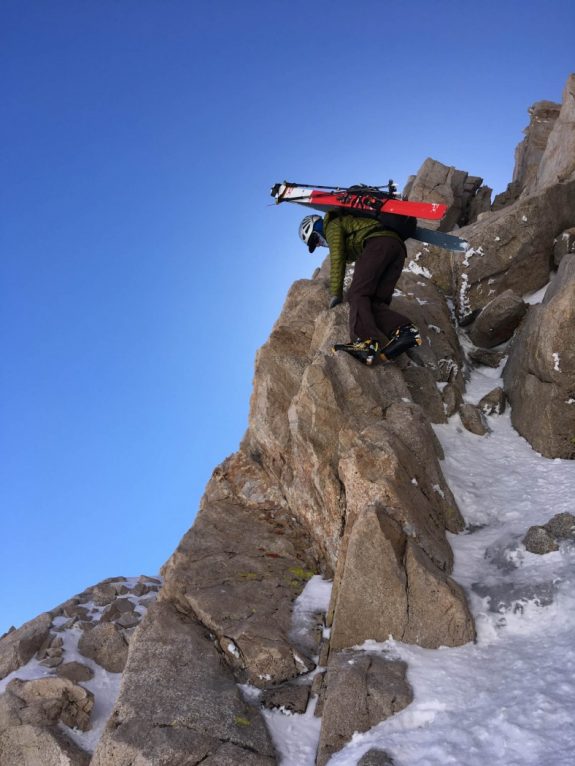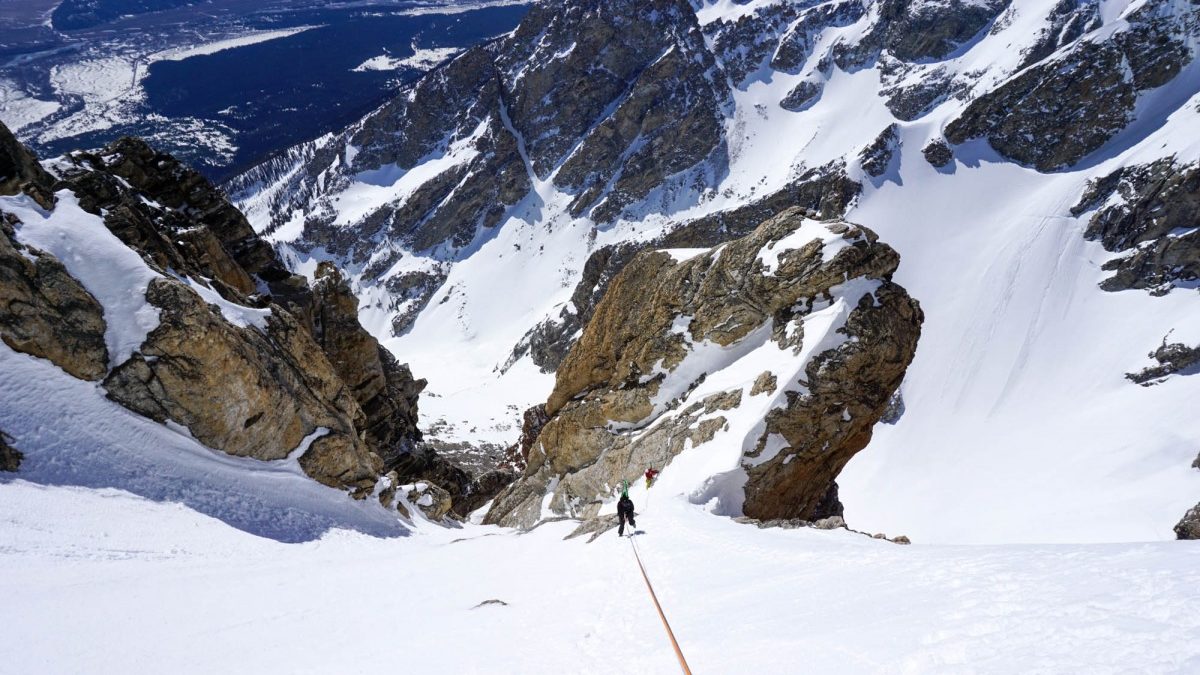Big thanks to onX Backcountry for sponsoring this post. Plan your ski mountaineering endeavors with 20% off your app subscription. Use the code WILDSNOW20 at checkout.
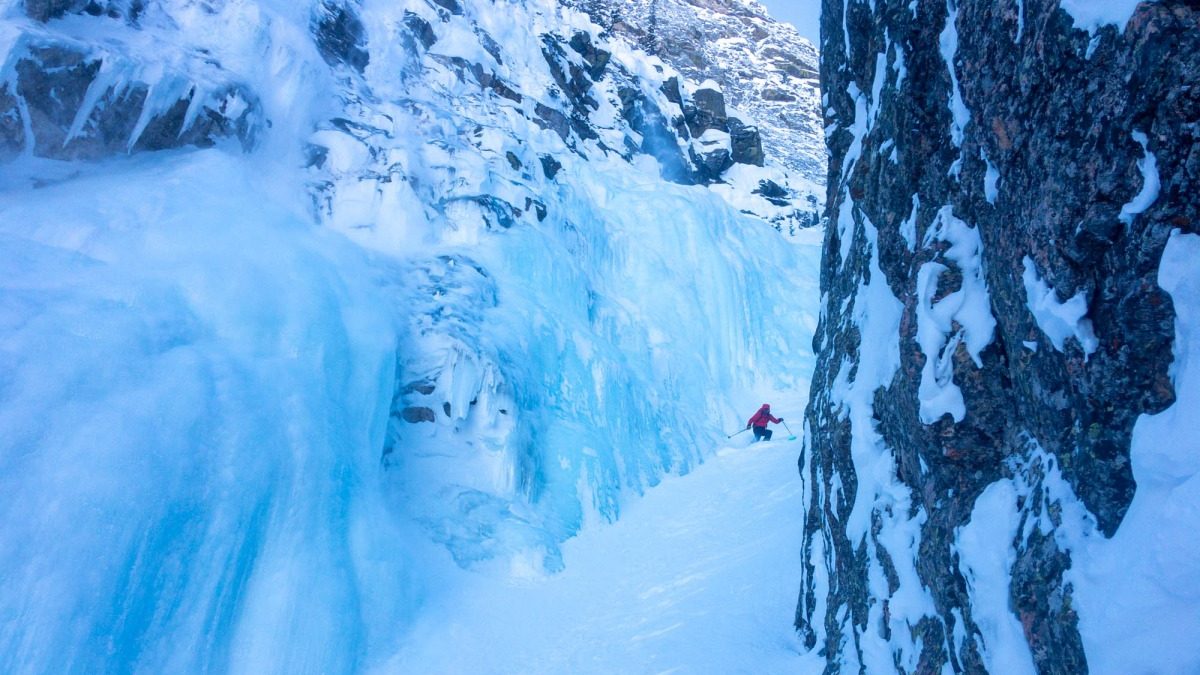
Apocalypse Couloir, Grand Teton National Park. Imaging climbing or descending this icy choke knowing that there were climbers above or below you? Evolved community convention has greatly increased the safety and appeal of this line.
Photos by Jed Porter
Is it time to flip your script? Where do you stand on skiing something “top down” vs “bottom up”? Do you always climb what you intend to ski, or do you try to go up a different way? How much do you think about it? Do you do it how you know others to do it?
There are various risk- and stress-management criteria at play in any given choice on this matter. Further, there are cultural and crowd-control matters to consider.
Convention holds that, given the choice, it is best to climb what you will ski for previewing of conditions. That has always meant longer and more vulnerable exposure to any natural hazards above, but it has largely been justified for the information it gives a skier. There are sometimes emotional, efficiency and/or aesthetic reasons to lean one direction or the other. Any one party, in isolation, makes their choice based on this soup of criteria.
In the popular, steep, tight, confined ski mountaineering terrain that we like so much, I think it is time to largely abandon “bottom-up” dogma. If the choice exists to climb a different way, elevate your planning process and skills to better anticipate the conditions and then ski your line “top down”. It is an aesthetically pleasing, community-minded, risk-reducing strategy.
Chances are, most of us are doing most of our skiing with historical heuristics. “This other person did it that way, I’ll do it that way too”. “I did it this way last time, I’ll do it this way again”. That’s not inherently wrong. We need to short-cut at least some of the myriad choices we have to make.
But, what about when things change since that convention was established? What do we do when we get better at certain parts of the ski mountaineering planning process? If Slator Aplin and Rob Coppolillo et al keep spilling their wisdom here on WildSnow, we’re all going to get a lot better at anticipating conditions, fast. What do we do when other major variables change? Like the number of people (generally and specifically on our intended line) out and about? There are many, many reasons to believe that the mountains are going to stay popular. I’d argue that, with both better conditions knowledge (individually and collectively) and with more people on skis, the era of “you must climb what you ski” is ending.
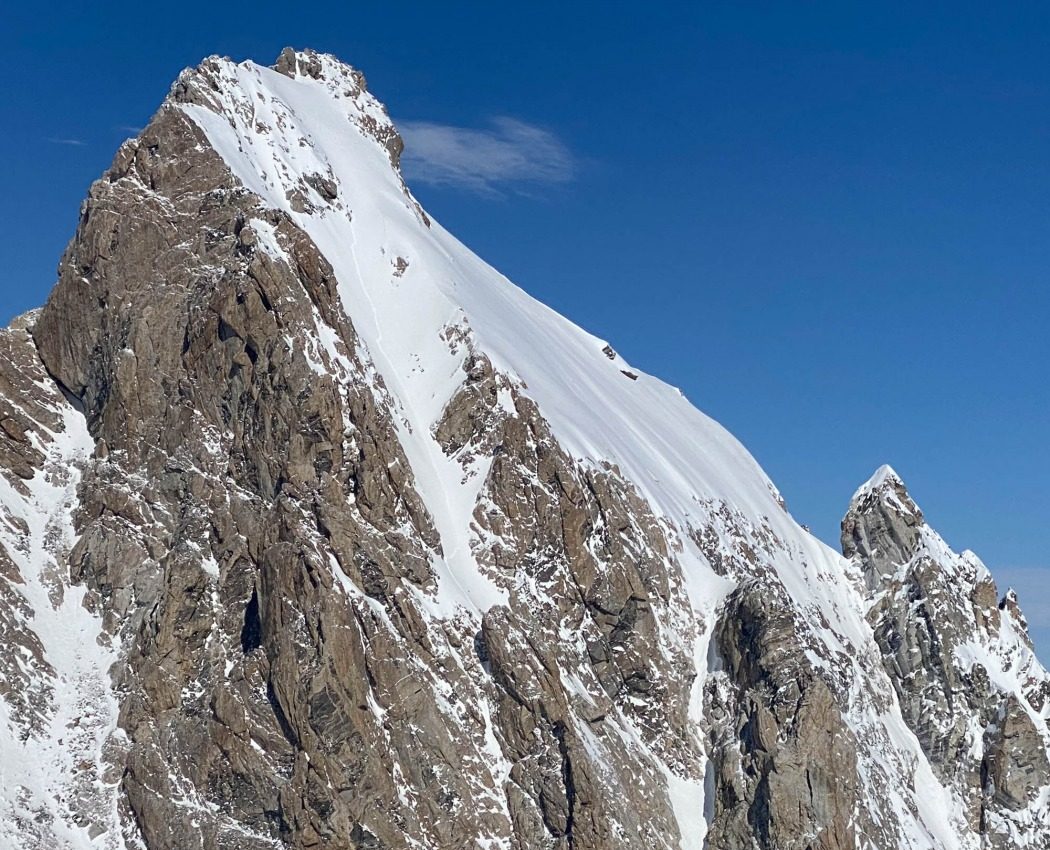
A February powder day on the Grand Teton. All these skiers had a great day. But they also moved many, many tons of snow down the ski line. What if there had been others below? What if they had some level of confidence that there were none below?
With more and more people around, the convention of “bottom-up” skiing loses at least a little value. In a line with others also in it, the “overhead” hazards are greater, with both more triggers (humans) and more assets (humans) in the firing line for longer. Aesthetically, passing people up and down is an interruption, at best.
Also, we are getting better at ascertaining conditions from afar. More well-informed skiers, covering more ground and sharing their findings more freely are, collectively, better able to anticipate conditions in a ski line with out immediate, first-hand, direct knowledge.
Let’s look at some quick case studies.
The Apocalypse Couloir in the southern end of Grand Teton National Park is a “modern classic”. After its first known descent in 1994 (skied after climbing it) by one of the strongest ski mountaineering teams ever assembled, that team reported a terrifying avalanche “near miss”, post-holing sprints, and “emphatically discouraged attempting this objectively hazardous route”. In 2013 a team, climbing this same route to ski it, was avalanched and one of the mountaineers died. Since then, a top-down strategy has evolved (requiring 3-4 rappels that bottom-up suitors need not do. On the other hand, the ascent for top-down access is forested skinning right to the first rappel) and community convention has flipped. It is virtually unheard-of to climb the Apocalypse Couloir to ski it. Dozens of people ski it on the best days now, and bold practitioners ski it in powder snow, confidently and with extensive intentional ski cutting. If it were typically (or even occasionally) done “bottom up”, such traffic volume and aggressive snow movement would be irresponsible to criminal.
One of my most memorable guiding assignments was a ski mountaineering week in Silverton. A long time client of the late Doug Coombs (Yeah, that’s as intimidating as it sounds…) joined me for 6 huge, steep day trips. Every single one leveraged a car shuttle and “top down” tactics to maximize mileage, scenery, engagement, and risk management. Most days involved more than one ski descent. Adherence to bottom-up dogma would have greatly reduced our ski enjoyment and volume.
My “Red Line Traverse” in 2017, documented here on WildSnow, involved 25 classic, steep ski descents. All but one of those was done “top down”.
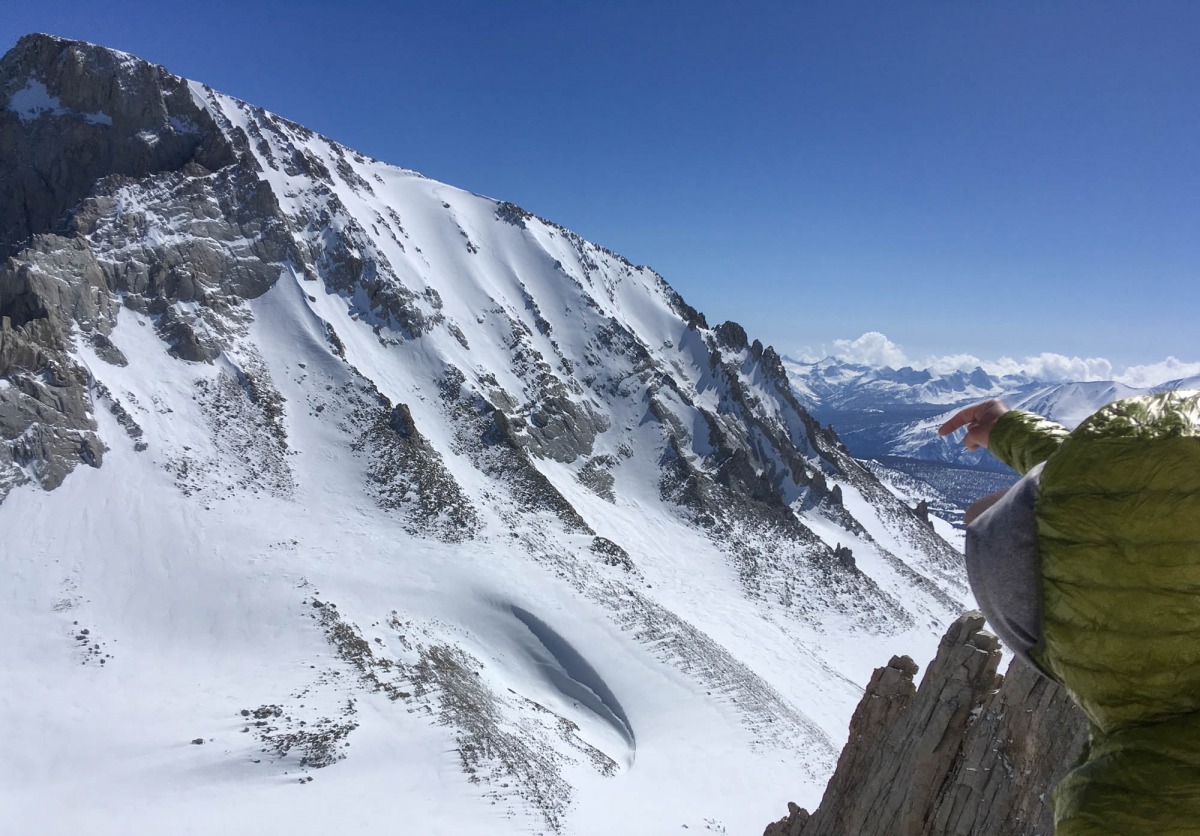
Descent number one of my 2017 Red Line Traverse. The NW Face of Mount Whitney. Done “on-sight”, top-down. And we then got to admire it head-on. In this case, from the S side of Mount Russell.
Let’s look again at the Tetons. This one is touchy and significant. Why not ski the Grand Teton’s classic Ford-Stettner top down? Skiing the Grand Teton is a life-time goal for many ski mountaineers. As it should be. To stand on that pointy summit with skis is absolutely spectacular. Any one party, as evidenced by hundreds of parties over decades now, can climb up and ski down the Ford-Stettner route. Virtually everyone that has done so in the last 10 years, however, reports various levels of exposure to, and complications with, other parties and associated hazards. Gear dropped on one another, ice and snow dropped on one another, bottlenecked delays, outright shut-down, etc.
The alternative is to climb the Owen-Spaulding route to the summit before skiing the F-S. Hazards aren’t eliminated with an OS ascent and a top-down descent, but net risk has to be reduced. Have all parties on any given day climb the OS and descend the Ford and risk reduction, on a community basis, compounds significantly.
In most conditions and for most ski alpinists, climbing the OS is harder than climbing the Ford-Stettner. But in virtually all conditions, and especially with other parties in the mix, climbing the OS is significantly more protected from overhead hazard than the F-S.
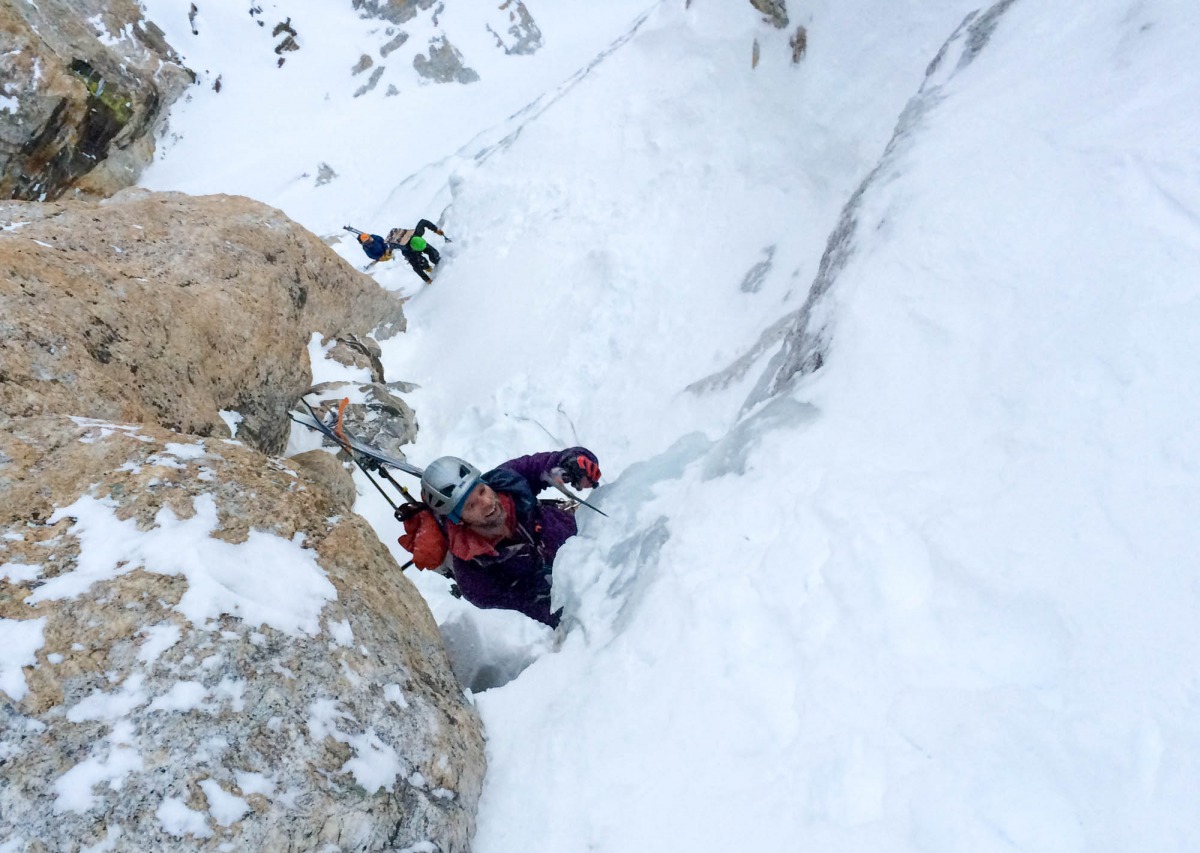
Conga line climbing the Grand Teton’s Ford-Stettner route. One of those alpinists went home that day with a gnarly cut to the shin. Not directly crowd-related, but not independent of the crowding either.
Climbing the Ford-Stettner route is slightly faster (if you aren’t bottlenecked by descending skiers) and slightly less technical than climbing the Owen-Spaulding. If you “on-sight” climb and ski the F-S you only have to route-find while ascending; you’ve previewed the route for descent. These are good reasons to do it “bottom-up”. However, climbing the F-S is a little to a lot more hazardous than climbing the OS.
Let’s discuss. As we do so, some prompts.
First, let’s discuss with the entire community in mind. I hope that it is abundantly clear that the “top down vs bottom up” calculus is quite different without both the liabilities and benefits of a greater number of skiers in the mountains. Or is that an unsound assumption on my part?
Next, yeah, this is fairly “advanced” stuff. But it is also a mental process that every one of us can understand and contribute to.
How much of the collective and individual adherence to “bottom-up” dogma is emotional? Ski mountaineering is emotionally taxing. The uncertainty is stressful. There is a significant stress-management benefit to walking up what you hope to eventually ski. But, does that emotional balm come at the expense of actual risk exposure? Can the personal stress-management skill required to ski something you haven’t yet touched be cultivated?
Jed Porter is a passionate adventure skier and all-around mountain professional. His primary work is as a mountain guide, skiing and climbing all over the Americas and beyond. Learn more about him at his website linked below.

